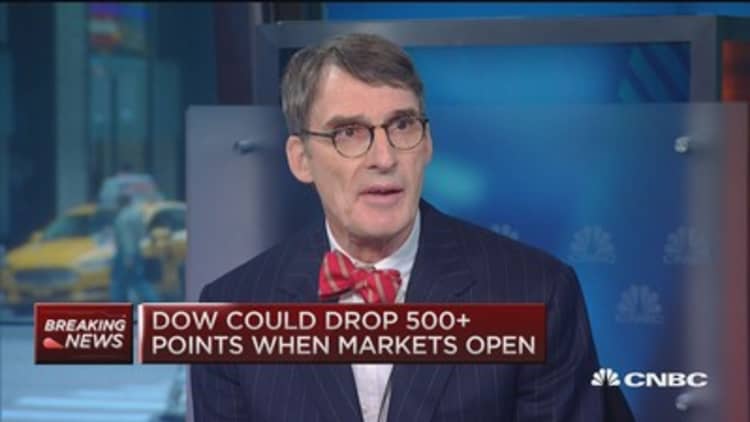
Central bank activity has provided the backdrop to the stock market's recent selloff, closely followed market watcher Jim Grant said Monday.
"It's the mispricing of asset values led by central banks who think that by inflating or lifting up stocks, bonds, real estate they will thereby engender prosperity," he told CNBC's "Squawk Box."
Grant made his comments as U.S. stock futures pointed to a sharply lower open Monday after last week's selloff. The Dow Jones industrial average fell more than 520 points Friday, bringing the index's losses for the week to 1,017.
As of Friday the Dow, Nasdaq and Russell 2000 were all down more than 10 percent from recent peaks, putting them in correction territory. The had its worst week in nearly four years.
Read More Mark Grant: US 10-year yield to hit 1.75%
The mispricing of assets does two things, according to Grant. It pulls demand forward and pushes failure out. He pointed to the junk bond market as an example of central bank intervention. He noted that default rates in the space during the last year were 2.3 percent on average, compared with the average of 4.6 percent going back to 1970.
Companies are borrowing more at this phase of the financing cycle when they might have drawn down debt in the past, he said. That is in part because the terms dictating how that debt will be paid back is looser than it has been in the past, he explained.
"It gives companies a great deal more latitude to persist and to expand and survive," Grant said. "Now, in capitalism there is meant to be failure. It's like the forest floor. There is life, there is regeneration, there is death. Without that, what you find is a bunch of dead ferns. What we have in America it seems to me is more and more evidence of fernitization."
The Federal Reserve has given the United States a system of enterprise that is much slower to change, he added.
Read MoreDavid Katz: Don't get too crazy about this selloff
By printing more money and suppressing interest rates, the U.S. central bank sought to stimulate aggregate demand, but also inadvertently stimulated aggregate supply, he said. That has led to more capital expenditures, production and oil supply.
The Fed has held interest rates near zero since December 2008.
The "lot of everything" that policy has produced weighs on price indices, leading the Fed to print more money and further suppress rates in order to meet inflation targets, Grant said.
He acknowledged that his earlier call that inflation would ramp up was wrong, but said inflation manifests in different ways.
"It seems to me the really pernicious inflation of this cycle has been the systematic comprehensive mispricing of asset prices," Grant said.


